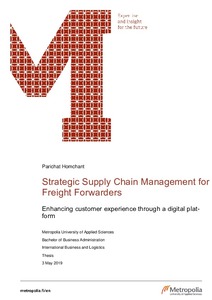Strategic Supply Chain Management for Freight Forwarders: Enhancing customer experience through a digital platform.
Homchant, Parichat (2019)
Homchant, Parichat
2019
All rights reserved. This publication is copyrighted. You may download, display and print it for Your own personal use. Commercial use is prohibited.
Julkaisun pysyvä osoite on
https://urn.fi/URN:NBN:fi:amk-2019060113944
https://urn.fi/URN:NBN:fi:amk-2019060113944
Tiivistelmä
The aim of this study is to elaborate on the latest phenomenon in the freight forwarding industry as digital freight platform in which how it can improve customer experience. The objectives of this study were to study not only the context of supply chain management in freight forwarding companies, but it also raises awareness of digitalisation concept that influences the seamless supply chain.
Customers experience become the heart of all business industries, even in the era of digitalisation, where technology plays an essential role in any businesses. Customers need service process simple, faster, and with transparency, various businesses already approached customers through a digital online platform, likewise, in the freight forwarding industry. For the past few years, many world’s leading freight forwarders implement the digital platform to satisfy the customers.
The nature of this study is exploratory, to gain a profound understanding of their provision to the customer, the perception towards the platforms and the future of the industry. Thus, a qualitative approach was used. The primary data was collected through in-depth interviews with two company studies: Twill logistics Thailand and Panalpina Finland. The secondary data was collected from literature, company’s reports, websites and blogs.
The findings indicate how the digital platform benefits to customers and with its advantages to enhance the customer experience in a new way. Listening to customers is the main key. Besides, the Gaps model of service quality and 3E’s framework are considered. The gaps are discrepancies between the customer’s expectation and perception of service, which need to be closed. The 3-E framework includes easy, effective and emotional. Minimising the gaps and well-managed customer satisfaction could help companies gain brand loyalty. In addition, the findings also show that challenges and limitations of the platform are the critical issues for companies to overcome and lead their competitor. Finally, one common perception for freight forwarder is the small traditional freight forwarders will be left out if they do not adapt to digital transformation.
Customers experience become the heart of all business industries, even in the era of digitalisation, where technology plays an essential role in any businesses. Customers need service process simple, faster, and with transparency, various businesses already approached customers through a digital online platform, likewise, in the freight forwarding industry. For the past few years, many world’s leading freight forwarders implement the digital platform to satisfy the customers.
The nature of this study is exploratory, to gain a profound understanding of their provision to the customer, the perception towards the platforms and the future of the industry. Thus, a qualitative approach was used. The primary data was collected through in-depth interviews with two company studies: Twill logistics Thailand and Panalpina Finland. The secondary data was collected from literature, company’s reports, websites and blogs.
The findings indicate how the digital platform benefits to customers and with its advantages to enhance the customer experience in a new way. Listening to customers is the main key. Besides, the Gaps model of service quality and 3E’s framework are considered. The gaps are discrepancies between the customer’s expectation and perception of service, which need to be closed. The 3-E framework includes easy, effective and emotional. Minimising the gaps and well-managed customer satisfaction could help companies gain brand loyalty. In addition, the findings also show that challenges and limitations of the platform are the critical issues for companies to overcome and lead their competitor. Finally, one common perception for freight forwarder is the small traditional freight forwarders will be left out if they do not adapt to digital transformation.
